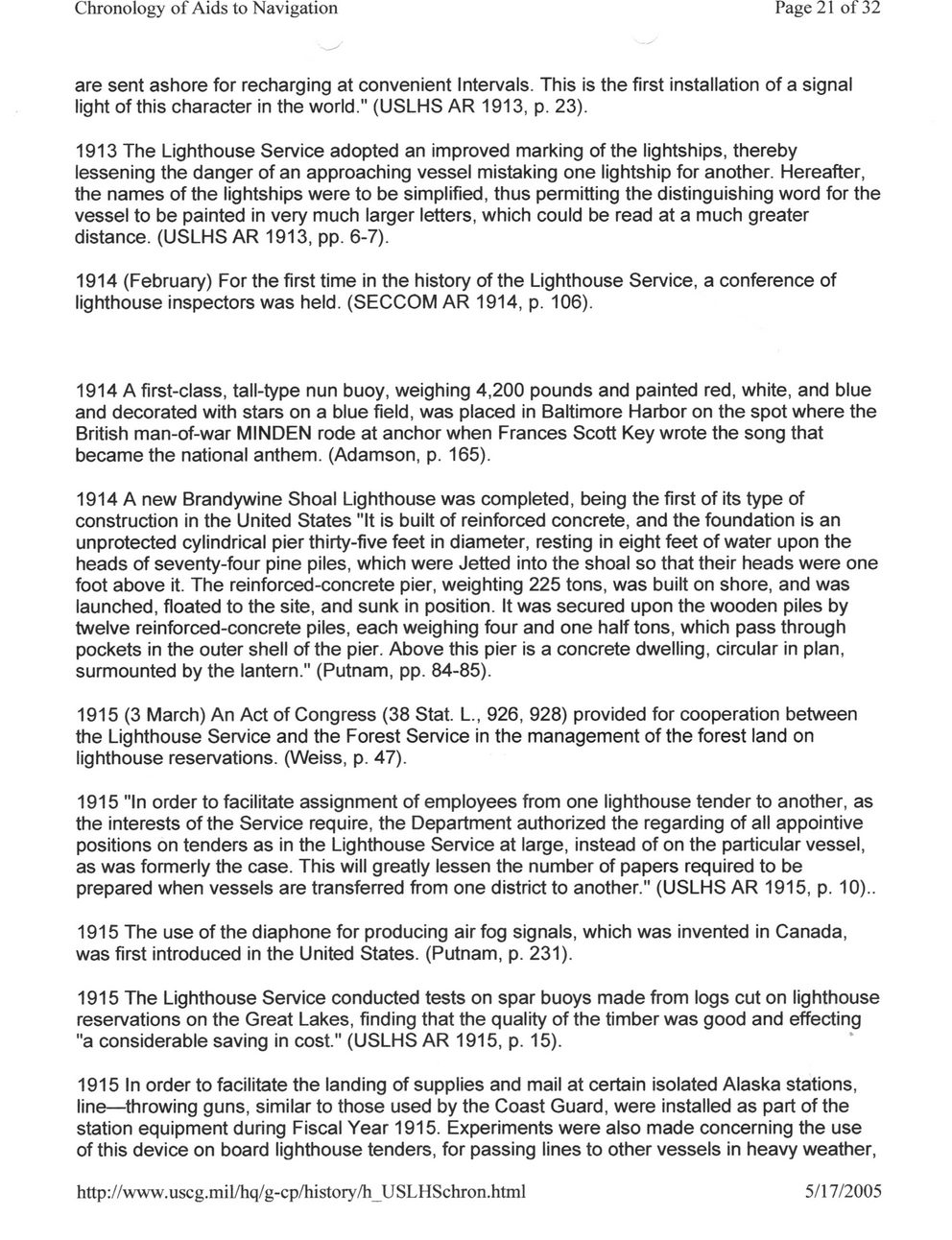This text was obtained via automated optical character recognition.
It has not been edited and may therefore contain several errors.
Chronology of Aids to Navigation Page 21 of 32 are sent ashore for recharging at convenient Intervals. This is the first installation of a signal light of this character in the world." (USLHS AR 1913, p. 23). 1913 The Lighthouse Service adopted an improved marking of the lightships, thereby lessening the danger of an approaching vessel mistaking one lightship for another. Hereafter, the names of the lightships were to be simplified, thus permitting the distinguishing word for the vessel to be painted in very much larger letters, which could be read at a much greater distance. (USLHS AR 1913, pp. 6-7). 1914 (February) For the first time in the history of the Lighthouse Service, a conference of lighthouse inspectors was held. (SECCOM AR 1914, p. 106). 1914 A first-class, tall-type nun buoy, weighing 4,200 pounds and painted red, white, and blue and decorated with stars on a blue field, was placed in Baltimore Harbor on the spot where the British man-of-war MINDEN rode at anchor when Frances Scott Key wrote the song that became the national anthem. (Adamson, p. 165). 1914 A new Brandywine Shoal Lighthouse was completed, being the first of its type of construction in the United States "It is built of reinforced concrete, and the foundation is an unprotected cylindrical pier thirty-five feet in diameter, resting in eight feet of water upon the heads of seventy-four pine piles, which were Jetted into the shoal so that their heads were one foot above it. The reinforced-concrete pier, weighting 225 tons, was built on shore, and was launched, floated to the site, and sunk in position. It was secured upon the wooden piles by twelve reinforced-concrete piles, each weighing four and one half tons, which pass through pockets in the outer shell of the pier. Above this pier is a concrete dwelling, circular in plan, surmounted by the lantern." (Putnam, pp. 84-85). 1915 (3 March) An Act of Congress (38 Stat. L., 926, 928) provided for cooperation between the Lighthouse Service and the Forest Service in the management of the forest land on lighthouse reservations. (Weiss, p. 47). 1915 "In order to facilitate assignment of employees from one lighthouse tender to another, as the interests of the Service require, the Department authorized the regarding of all appointive positions on tenders as in the Lighthouse Service at large, instead of on the particular vessel, as was formerly the case. This will greatly lessen the number of papers required to be prepared when vessels are transferred from one district to another." (USLHS AR 1915, p. 10).. 1915 The use of the diaphone for producing air fog signals, which was invented in Canada, was first introduced in the United States. (Putnam, p. 231). 1915 The Lighthouse Service conducted tests on spar buoys made from logs cut on lighthouse reservations on the Great Lakes, finding that the quality of the timber was good and effecting "a considerable saving in cost." (USLHS AR 1915, p. 15). 1915 In order to facilitate the landing of supplies and mail at certain isolated Alaska stations, line—throwing guns, similar to those used by the Coast Guard, were installed as part of the station equipment during Fiscal Year 1915. Experiments were also made concerning the use of this device on board lighthouse tenders, for passing lines to other vessels in heavy weather, http://www.uscg.mil/hq/g-cp/history/h_USLHSchron.html 5/17/2005

Lighthouses Chronology-of-Aids-to-Navigation-(21)